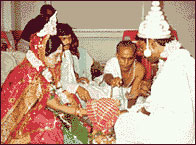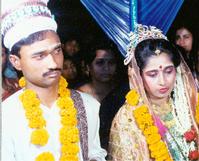The Wedding Ceremony of the Bengalis
 Introduction
Introduction
The traditional Bengali wedding ceremony combines Vedic
scriptures with regional traditions, Bengalis have created a synthetic and
beautiful marriage ceremony.
The Indian
region of West Bengal and its pre-partition eastern counterpart, modern day
Bangladesh, provide unique variations to the classic Hindu marriage.
Pre-Wedding Rituals
The days before a Bengali wedding are
filled with several key additions. The first of these is Ashirwaad. Very similar
to the ritual blessing offered after a classic Hindu wedding, in this Ashirwaad,
a pundit gives the couple blessings prior to the ceremony.
The second
Bengali pre-wedding tradition is a feast held for the bride the night before the
wedding. This meal, the Ai Buddo Bhaat, allows family and friends of the bride
to wish her well and help her prepare for the wedding day ahead.
The Wedding Day
The day of the wedding begins early for the bride with the Haldi Uptan.
In this ritual, she is anointed with turmeric, giving her skin a
soft glow. After this treatment, the bride participates in another tradition
called Shakha Paula. In this ritual, seven married women place traditional
marriage bangles on the bride's hands. The seven women represent the seven forms
of God; one for each day of the week.


The wedding morning starts with the
groom receiving new wedding clothes from his relatives in a ceremony called
Potto Bastra. The groom is then dressed in his gift, normally a conventional
wedding suit. In a traditional bharaat, the groom and his entourage then head
off for the wedding.
As the couple individually makes their way to the
wedding hall, a famous Bengali tradition takes place: The oolu-oolu and the
blowing of the conch. Oolu-oolu is the onomatopoeic term referring to a sound
made by Bengali women simultaneously moving their tongues and beating their
mouths with an open palm. The oolu-oolu, performed by women of both families, is
meant to draw widespread attention to the wedding ceremony. To compliment the
oolu-oolu, a conch is blown.
The Ceremony
When the bride and
groom arrive at the wedding, they meet each other with a ritual exchange of
flowered garlands or phool malas. Their hands are then joined with a sacred
thread and the couple is blessed in the Sampradan ceremony.


The couple isfirst ritually seated in front of the Agni (sacred fire) in a small ceremony
named Yagya. As the ceremony proceeds, the couple is asked to stand and walk
seven times around a decorative circular pattern on the floor, reminding them of
the sanctity and solemnity of marriage. These seven rounds are known as Saat
Pheras.
After Saat Pheras in Anjali ceremonies, an offering is made to
the fire. Although many Hindu type weddings involve fire offerings, Anjali is
typical of and specific to Bengali weddings.
A traditional Bengali
wedding is completed with the Sindoor Daan. The groom applies the symbol of
marriage to his bride's hair parting: a red marking (Sindoor). As a Hindu woman,
the bride will wear this symbol from the time of the Sindoor Daan until her
death. The groom then offers his bride a new sari with which she covers her
head. With this the couple is then considered officially married.
After the Wedding]
The wedding ceremony is followed by a reception for the guests.
The reception is usually a spectacular display.
After the reception,
the bride leaves behind her old life and family, becoming a member of the groom's family
instead. In the ritual Bidaai, the bride's family both grieves their loss and wishes her
joy in her new life.
Even as the couple leaves together they are not yet free to
begin married life. First, in the Kaal Ratri, the couple is separated and the girl
cooks and serves a meal for her new family. This action, Bohu Bhaat, marks the
girl's entrance into her new family. After Bohu Bhaat, the couple is garlanded
with flowers in the Phool Shojja ceremony. They are then free to start married
life.
|


 Introduction
Introduction


